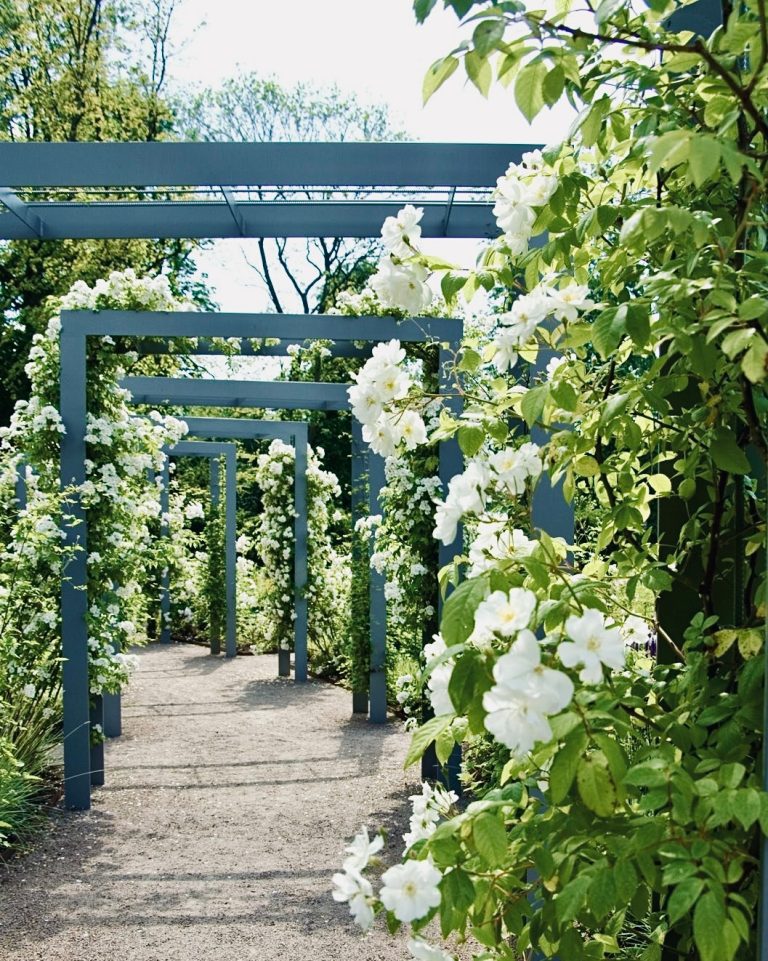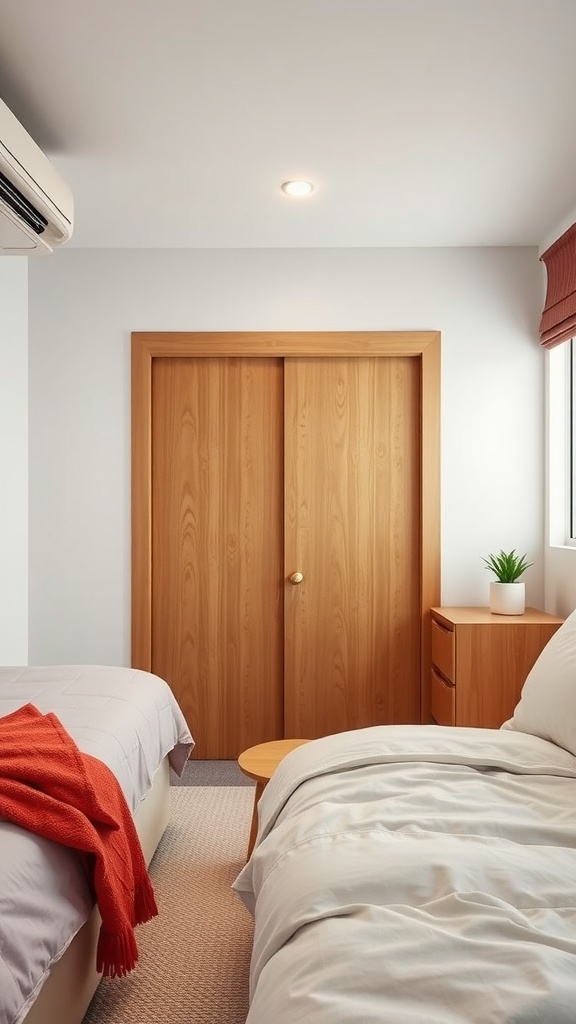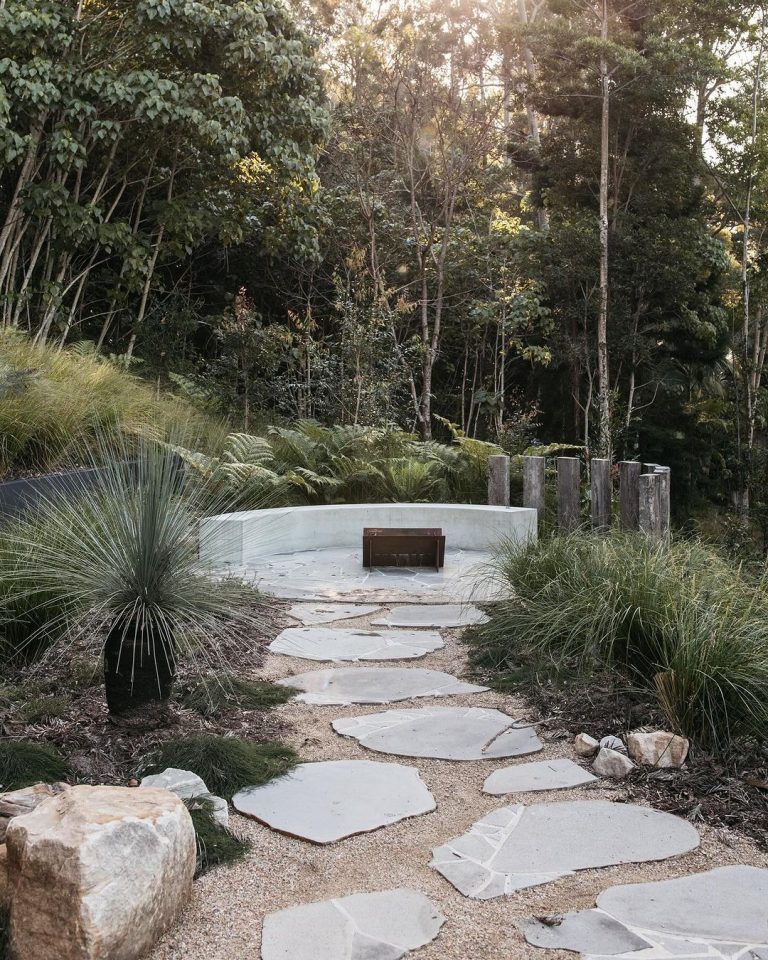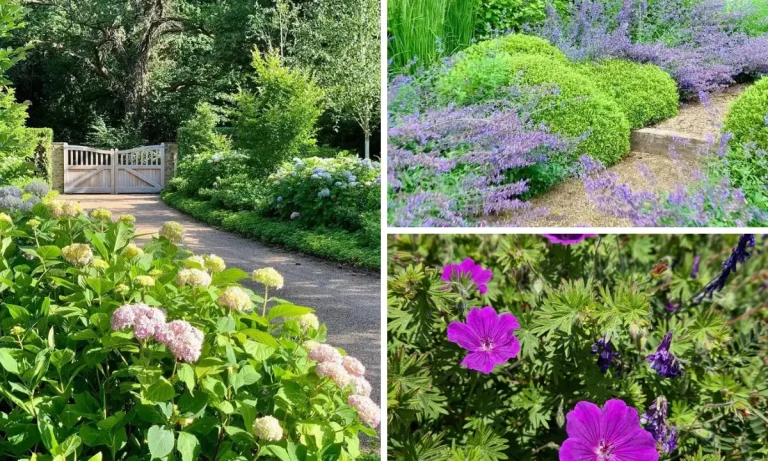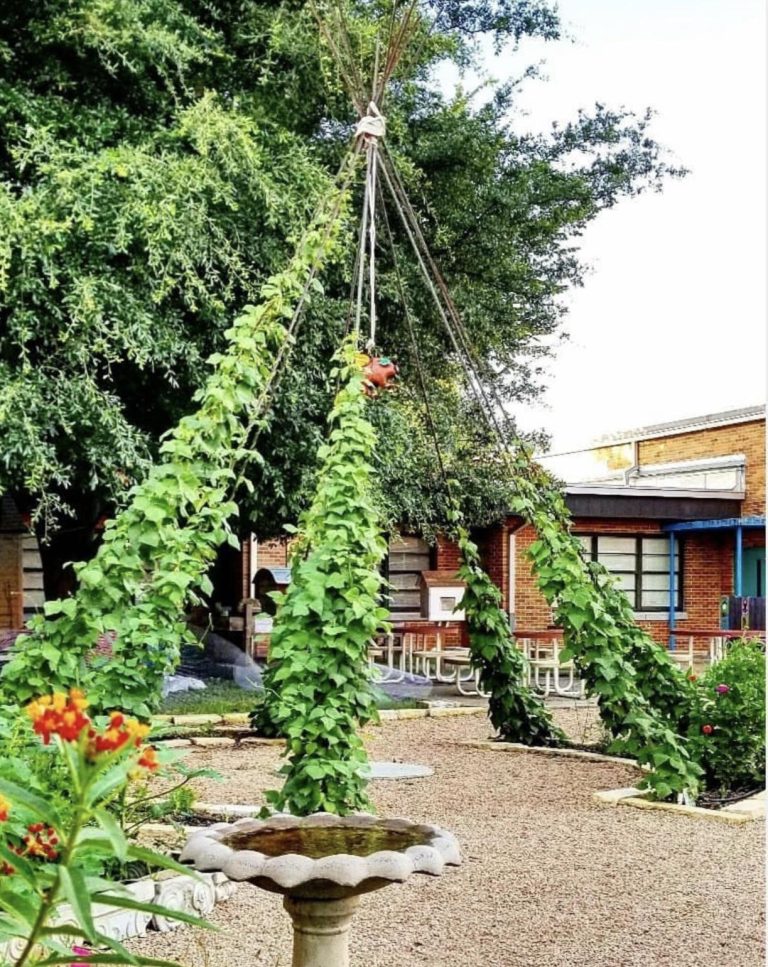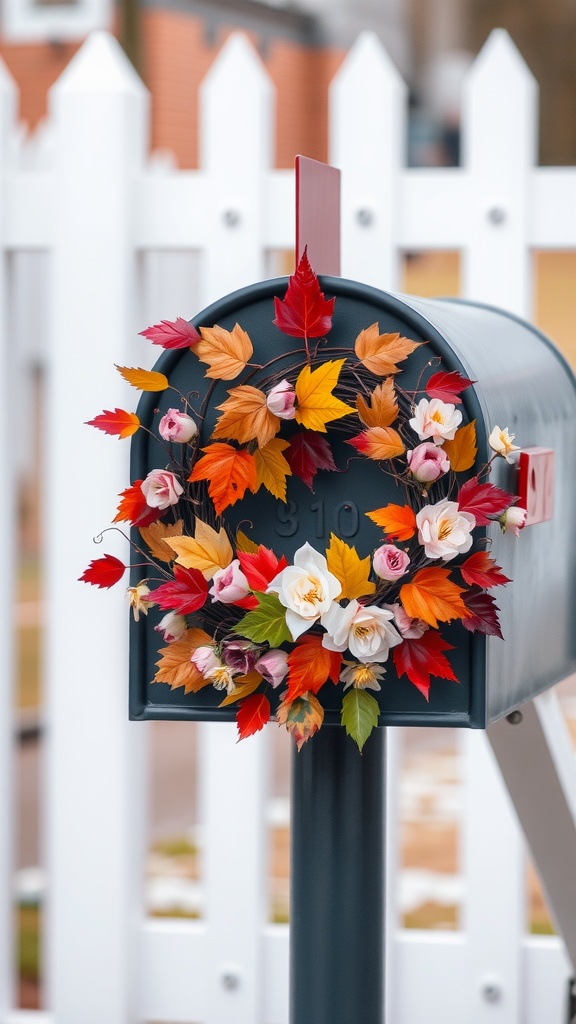19 Brick Garden Edging Ideas to Elevate Your Outdoor Living Space
Looking to give your garden beds a crisp, classic finish that oozes charm and function? Brick garden edging might be just what you need.
Whether you’re aiming for vintage cottage vibes or a clean modern back porch look, brick edging can beautifully define flower beds, walkways, and lawns while offering long-lasting durability.
From traditional borders to creative raised beds and curved designs, these 19 brick garden edging ideas will help you transform your outdoor space into a stylish sanctuary.
Let’s explore the first ten ideas to inspire your garden makeover.
1. Traditional Flat Brick Border
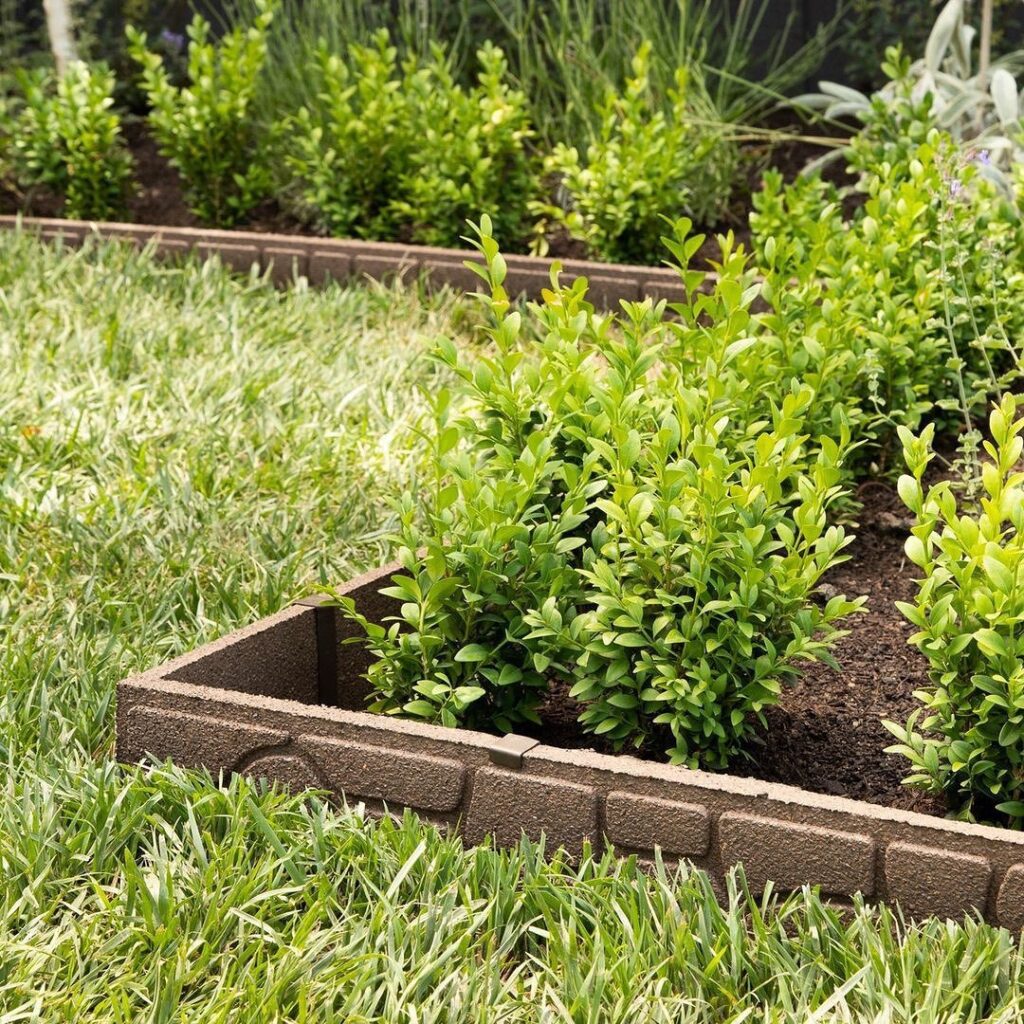
A traditional flat brick border is a timeless and budget-friendly choice that works seamlessly with most garden layouts.
By laying bricks flat and side by side, this edging design provides a clean, level boundary between your lawn and garden beds. It’s perfect for highlighting symmetrical landscaping or pairing with modern patio furniture in minimalist backyards.
This simple style doesn’t compete with your plants or back porch decor—it complements them. It also makes lawn maintenance a breeze, allowing your mower wheels to glide along the edge without damaging flowers or shrubs.
You can choose classic red bricks for a warm, rustic tone or opt for gray or cream-toned bricks for a sleeker, contemporary look.
Plus, installation is straightforward: dig a shallow trench, add a sand or gravel base, and press the bricks into place. Finish it with leveling and soil backfill, and you’ve got an elegant frame for your outdoor garden beds.
This edging idea strikes a beautiful balance between functionality and curb appeal—especially for those looking to give their yard structure without stealing the spotlight from other design elements.
2. Herringbone Pattern Brick Edging

Looking to add a touch of texture and sophistication to your landscape? A herringbone pattern delivers both in spades.
This diagonal interlocking design gives garden edging a dynamic feel that instantly boosts visual interest—great for breaking up plain grassy areas or accenting a modern back porch. The repeating V-shape also helps create movement in your outdoor layout, guiding the eye toward key focal points like planters or patio seating.
Crafting a herringbone pattern does require more planning and brick-cutting than a standard straight layout, but the payoff is a truly polished and professional appearance. It’s especially striking when bordered by a contrasting edge like metal or stone.
Consider using deep red or clay-colored bricks to play off warm-toned porch decor or opt for charcoal tones for a contemporary twist. Sealing the bricks after installation enhances their color and helps resist moss and weathering.
This stylish option is a fantastic way to blend charm and structure—ideal for front walkways, flower beds, or even highlighting a seating nook tucked beside your garden.
3. Raised Brick Garden Edge
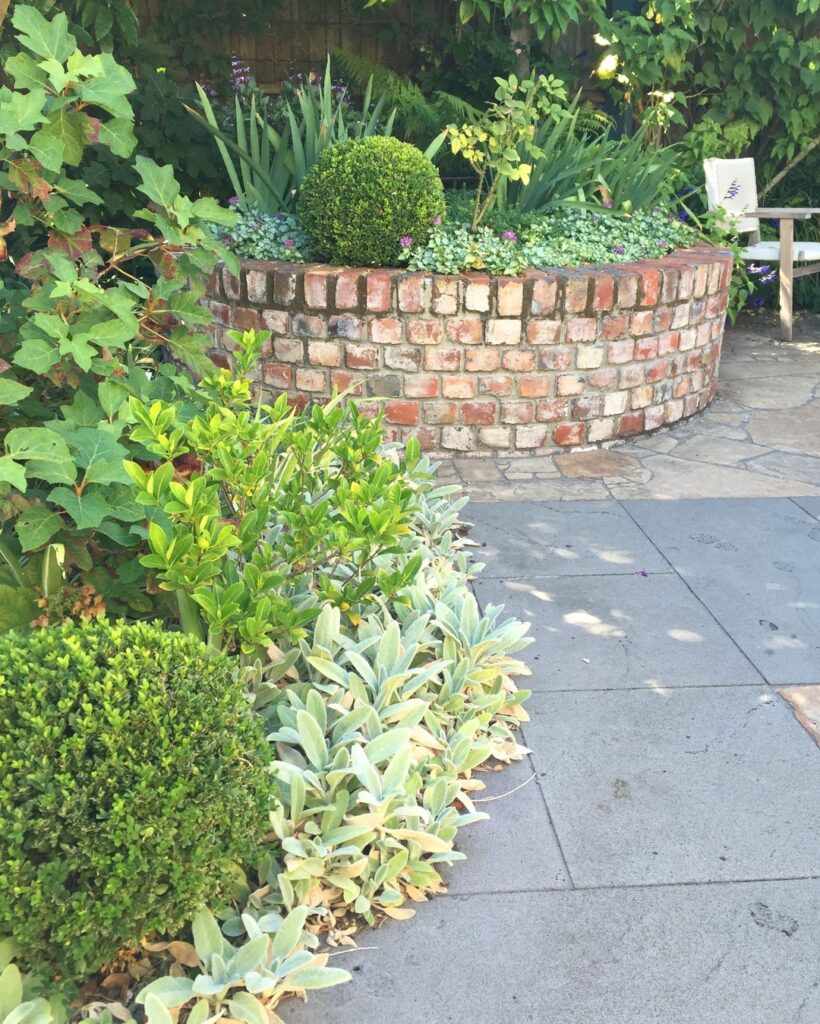
If you’re dreaming of a defined garden space that stands tall—literally—raised brick edging is a smart and stylish solution.
Rather than sitting flush with the ground, bricks are stacked and mortared to form a short retaining wall, typically one to three bricks high. This creates a raised garden bed effect, which not only adds dimension to your landscape but also improves drainage and reduces soil erosion.
Perfect for sloped yards or larger flower beds, this type of edging gives a tidy, elevated look that works well with structured landscaping and modern outdoor living areas.
The height also acts as a natural barrier to foot traffic and pets, protecting your plants while adding aesthetic structure. Pair raised brick edges with black mulch or river stones for a bold contrast that screams designer garden.
You can create smooth curves or straight lines depending on your layout. And if you’re going for a cottage garden or vintage vibe, consider aged or reclaimed bricks for added character.
It’s a great option for those looking to combine form and function without compromising on style.
4. Brick and Gravel Combo Edging
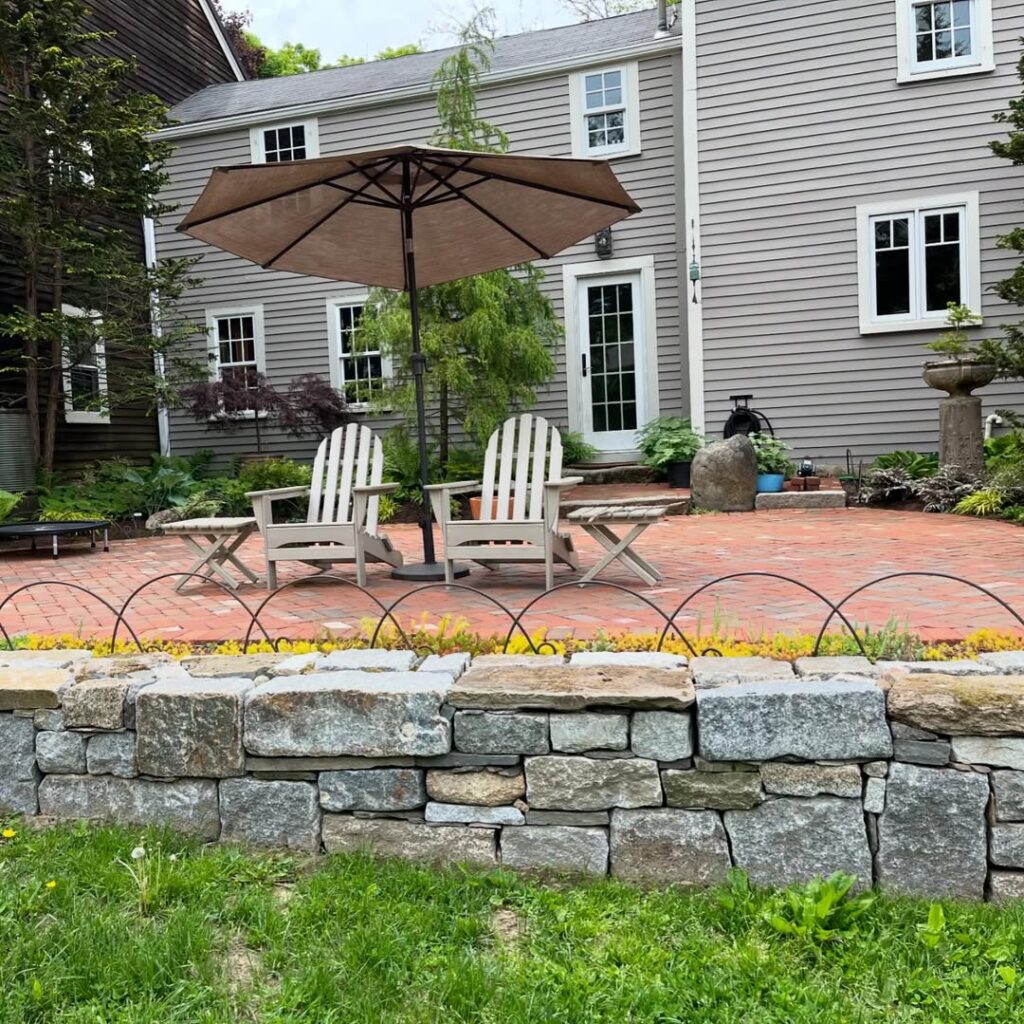
Combining brick edging with gravel creates a beautiful contrast in both texture and color—perfect for modern outdoor designs that aim for balance and visual depth.
This style features a line of flat or slightly angled bricks outlining a gravel bed that separates the lawn from your planting area. The gravel acts as a buffer, helping with drainage and preventing weed growth, while the brick provides a neat, structural frame.
You can choose from white pea gravel for a clean, airy look or dark river rocks for a more dramatic, earthy tone. Either way, it enhances the warmth and shape of the bricks.
This edging works wonders alongside modern patio furniture, especially in xeriscaped yards or drought-tolerant gardens where clean lines and minimal maintenance are key.
Pro tip: Use landscape fabric beneath the gravel to minimize weed intrusion and keep everything neat over time.
It’s an elegant yet low-maintenance choice that complements both traditional garden beds and more contemporary back porch decor.
5. Soldier Course Brick Edge
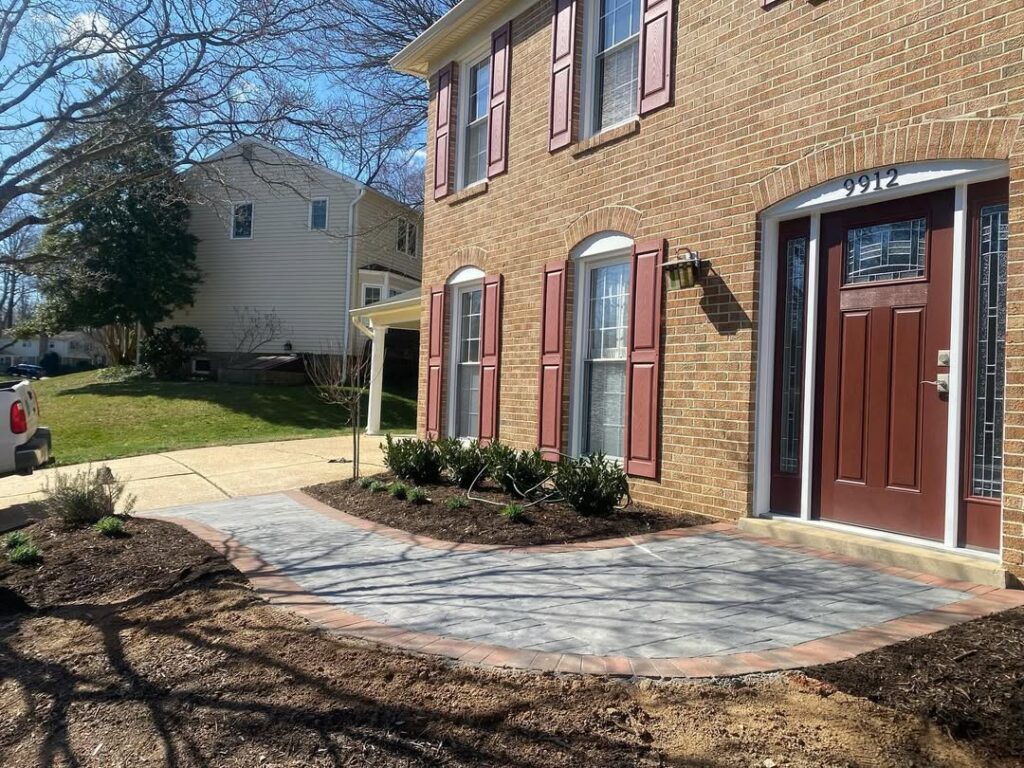
Want a bold and formal look for your garden beds? The soldier course layout delivers striking, upright lines that command attention.
In this design, bricks are placed vertically, standing on end in a row—much like soldiers in formation—creating a narrow, elevated edge that looks refined and intentional. It’s often used in classic English gardens but also fits beautifully with symmetrical, modern back porch layouts.
This edging provides a crisp separation between grass and garden, making it easy to maintain while adding a sense of formality to your landscape.
Soldier courses also make excellent borders for walkways or around patios, especially when paired with pavers or stamped concrete paths. You can use traditional red bricks for a classic feel or opt for sleek, dark bricks to match a contemporary color palette.
While installation may take a bit more effort to keep bricks straight and secure, the finished look is well worth it—and durable for years to come.
6. Reclaimed Brick Edging

There’s something undeniably charming about using reclaimed or vintage bricks for your garden edging. Each brick tells a story—whether it’s a weathered corner or a faded stamp from decades ago.
Reclaimed brick edging brings warmth, texture, and a bit of history to your outdoor living space. It’s ideal for cottage-style gardens, farmhouse yards, or even adding contrast to a more modern back porch aesthetic.
Beyond aesthetics, this eco-friendly choice gives new life to old materials. You can often find reclaimed bricks at architectural salvage yards or reuse centers, sometimes at lower prices than brand-new options.
Lay them flat, stack them for raised beds, or mix different tones and sizes for a rustic mosaic border. The irregularity gives your edging a hand-built, organic look that feels personalized and grounded.
Pair this edging with wildflower beds, antique planters, or weathered wood seating to complete the vintage garden vibe. It’s a wonderful way to make your landscape feel loved, lived-in, and unique.
7. Brick Edging with Ground Cover Plants
:strip_icc():format(webp)/bhg-bugelweed-cordial-canary-8a29a4c52d6e40c983c7cf0ef8aefd70.jpg)
For a soft, romantic edge that feels alive, combine traditional brick edging with creeping ground covers like thyme, creeping Jenny, or moss.
This approach lets greenery spill slightly over the edges, softening the hard lines of the brick and adding a sense of lushness and movement. It works beautifully in informal gardens, cottage landscapes, or as a transitional detail around your patio or back porch.
The bricks provide the boundary and structure, while the plants bring color and texture, especially between seasons when flowers aren’t in bloom.
Low-maintenance ground covers also help prevent soil erosion and act as a living mulch. Plus, they offer a gorgeous aroma if you choose scented varieties like creeping thyme.
This combination is both practical and poetic—adding elegance to your garden without constant upkeep. Just be sure to choose non-invasive, low-growing species for best results.
It’s a design element that proves function and beauty can go hand in hand.
8. Curved Brick Garden Edging
:strip_icc():format(webp)/curvy-brick-border-plants-flowers-101279494-a0ec4cd851154f1c8950ffe989a5821d.jpg)
If your garden beds follow a natural or winding shape, curved brick edging is the perfect way to emphasize their flow while keeping everything in check.
Bricks can be laid in gentle arcs or tighter spirals depending on your landscape design. You’ll likely need to use smaller bricks or cut standard ones to create smoother turns, but the effort adds undeniable elegance.
Curved edging feels more organic and works well with both soft landscaping (like wildflower gardens) and more curated zones with modern back porch features or seating areas.
This style also pairs beautifully with curved walkways, circular patios, or winding stepping stone paths—adding cohesion and visual rhythm to your outdoor living space.
If you want a border that feels artistic and custom—but still polished and practical—curved brick edging checks all the boxes.
9. Brick Edging with Inlaid Lighting
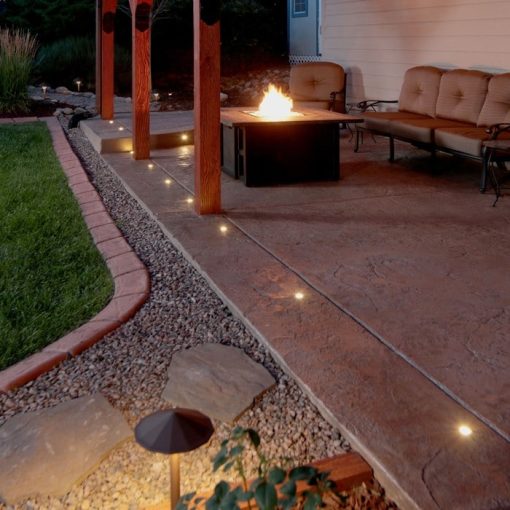
Want to bring your garden edging to life after sunset? Consider embedding solar or low-voltage lights into your brick border for a dramatic and functional touch.
This idea works especially well for framing walkways, highlighting flower beds, or outlining patio perimeters. The subtle glow adds ambiance and improves safety, making it easier to navigate your outdoor spaces at night.
You can purchase bricks with pre-cut holes for lighting inserts or create your own using a masonry drill. Solar lights are the easiest option since they don’t require wiring, but low-voltage options offer more brightness and control.
This edging concept blends modern patio decor with practical lighting design—and it looks amazing beside sleek patio furniture, cozy firepits, or outdoor dining areas.
Just be sure to choose weatherproof lighting made for in-ground installation to ensure durability through all seasons.
10. Basket Weave Brick Pattern
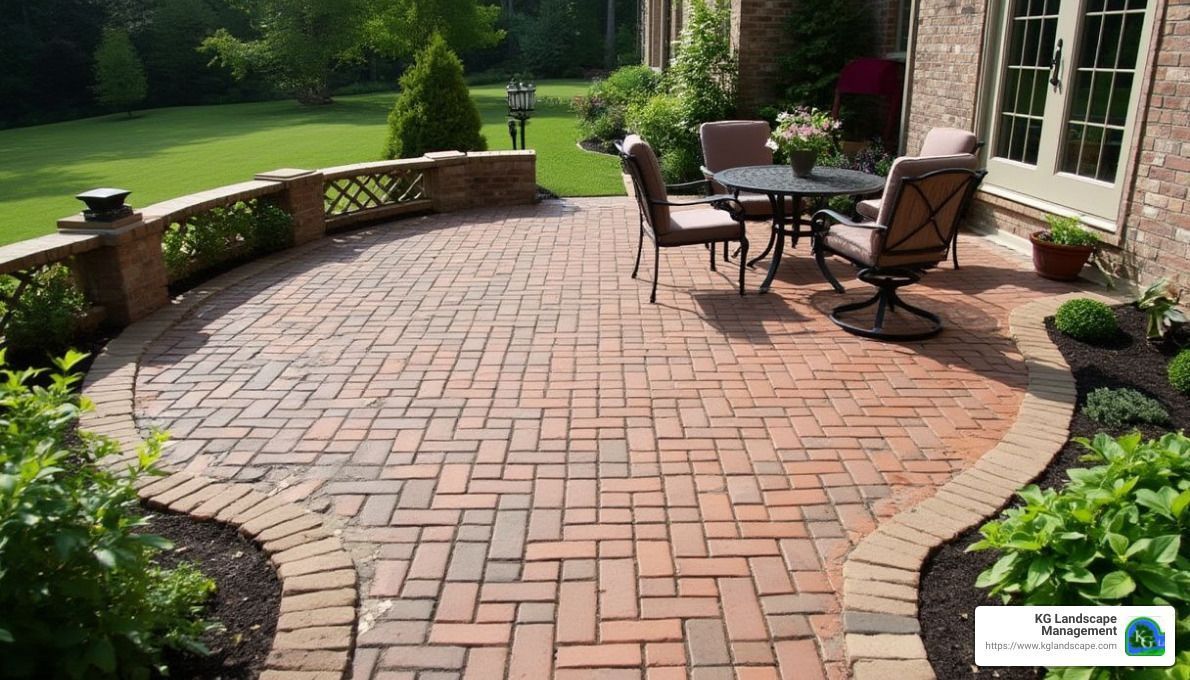
For a more intricate and decorative look, try a basket weave pattern for your garden edging.
This involves alternating pairs of horizontal and vertical bricks to mimic the crisscross look of a woven basket. The result is eye-catching and textured—great for adding a sense of artistry to your yard without going over the top.
Because it involves more detailed brick-laying, this style is best used in focal areas: around feature flower beds, raised planters, or near back porch seating zones where the detail will be noticed and appreciated.
To make the pattern pop, use bricks with varied shades or mix in decorative stone fillers between gaps. A sealed finish will keep the bricks vibrant and protected from moisture.
This layout pairs beautifully with formal gardens or more curated landscaping and lends a refined touch to even simple backyards.
11. Brick Edging with Mulch Buffer
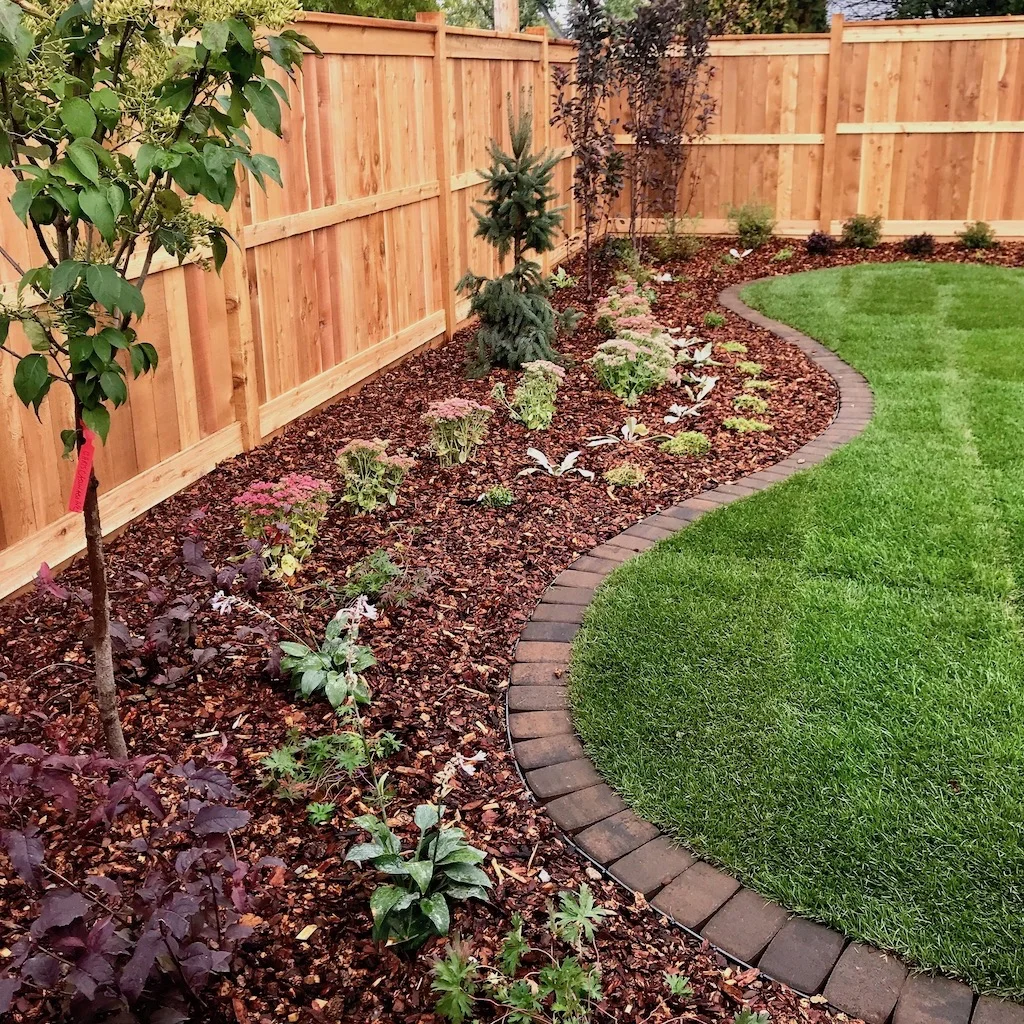
Combining brick edging with a mulch buffer is an easy and effective way to add polish to your garden beds while improving overall plant health.
This design uses bricks to create a structured border, then adds a small buffer zone of mulch between the bricks and your main garden bed. It’s a smart and visually appealing way to keep moisture in the soil, suppress weeds, and protect your plants’ roots from temperature swings.
From a design perspective, this style creates clean layers—brick, mulch, and then greenery—that work beautifully with back porch decor and patio furniture. The rich tones of red or brown mulch contrast nicely against both warm-toned and gray bricks, adding visual interest.
Installation is straightforward: set the brick edge first, then dig a shallow trench for mulch, and finish with a border or edging stake if needed to keep everything in place.
This layout suits a variety of home styles—from traditional to modern—and is especially helpful for low-maintenance gardening. If you’re aiming for a crisp and clean outdoor living space with minimal upkeep, this is a great option to explore.
12. Brick Edging Around Trees

Highlight the natural beauty of your yard’s trees by wrapping them in a ring of brick edging. Not only does this create a polished, defined look—it also protects tree roots from foot traffic and lawn equipment.
Circular brick borders work well with both mature trees and smaller ornamental ones. You can stack bricks for a raised effect or lay them flat for a subtle frame. For added impact, fill the space inside the ring with mulch, gravel, or shade-loving ground covers.
This style integrates well with modern back porch landscaping and helps tie your tree areas into the broader design of your outdoor space. The shape provides visual contrast to angular paths or square patios, making the whole area feel more curated and balanced.
Tree rings can also be installed as focal points within a larger lawn or flower bed area—giving your yard extra structure and style.
Whether you’re going for function, form, or both, brick edging around trees is an elegant and versatile landscaping solution.
13. Brick-on-Angle Edging
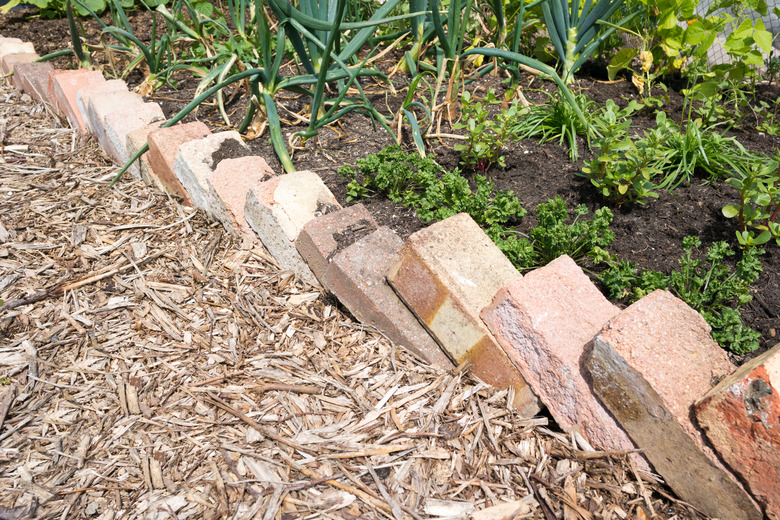
Want to make your brick edging stand out even more? Try setting your bricks at an angle—also known as a “diamond” or “sawtooth” pattern—for a bold, geometric effect.
This style features bricks tilted diagonally, so only the corners stick up from the ground. It’s a unique take that adds energy and rhythm to your garden design, especially along winding paths or flower beds.
Angled brick edging brings a dynamic texture that works great in more modern landscapes or those featuring decorative gravel, contemporary fencing, or minimalist garden beds. It also offers excellent water drainage around the edges of beds and helps reduce erosion in sloped areas.
When paired with other outdoor elements like modern patio furniture or a stylish fire pit area, this look feels fresh and intentional. It’s also a clever way to use bricks that may be chipped or imperfect—adding character without compromising structure.
Just be sure to secure the bricks firmly into a solid sand or mortar base so they don’t shift over time.
14. Brick Edging for Vegetable Beds
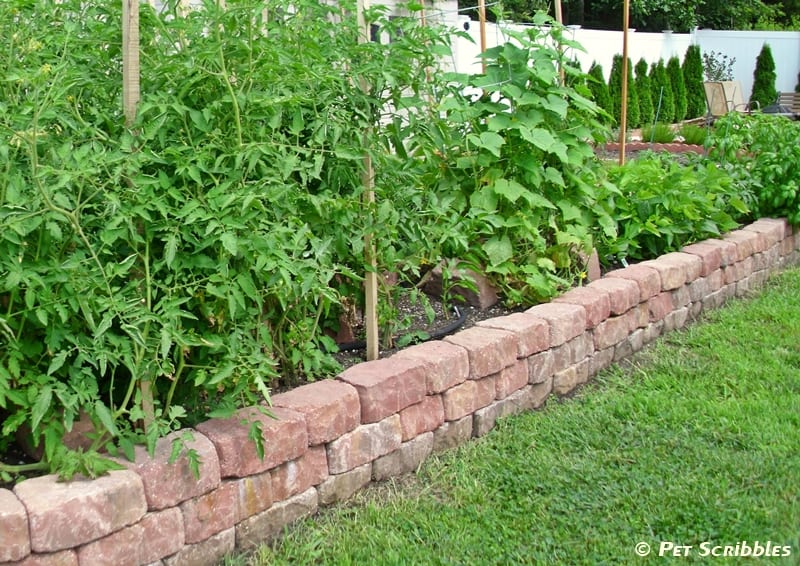
If you’re cultivating your own backyard veggie patch, brick edging is a functional and charming way to keep things organized and thriving.
Bricks provide a sturdy boundary that keeps soil in place and prevents mulch or compost from spilling into walkways. They’re also resistant to rot, making them an ideal choice for wet, high-maintenance areas like vegetable gardens.
Flat brick edging works great around raised beds, while stacked or mortared bricks can be used to create full-height planter boxes. Both options bring structure and style, making your garden not only productive but beautiful too.
The earthy tone of brick pairs well with leafy greens, herbs, and colorful produce—adding a rustic yet tidy look to your outdoor living area.
For a cohesive aesthetic, coordinate your brick vegetable beds with other landscape features—like matching pathways, a brick patio edge, or a cozy back porch. It’s a simple way to elevate a utilitarian space into one that feels curated and intentional.
15. Brick Edging Along Walkways
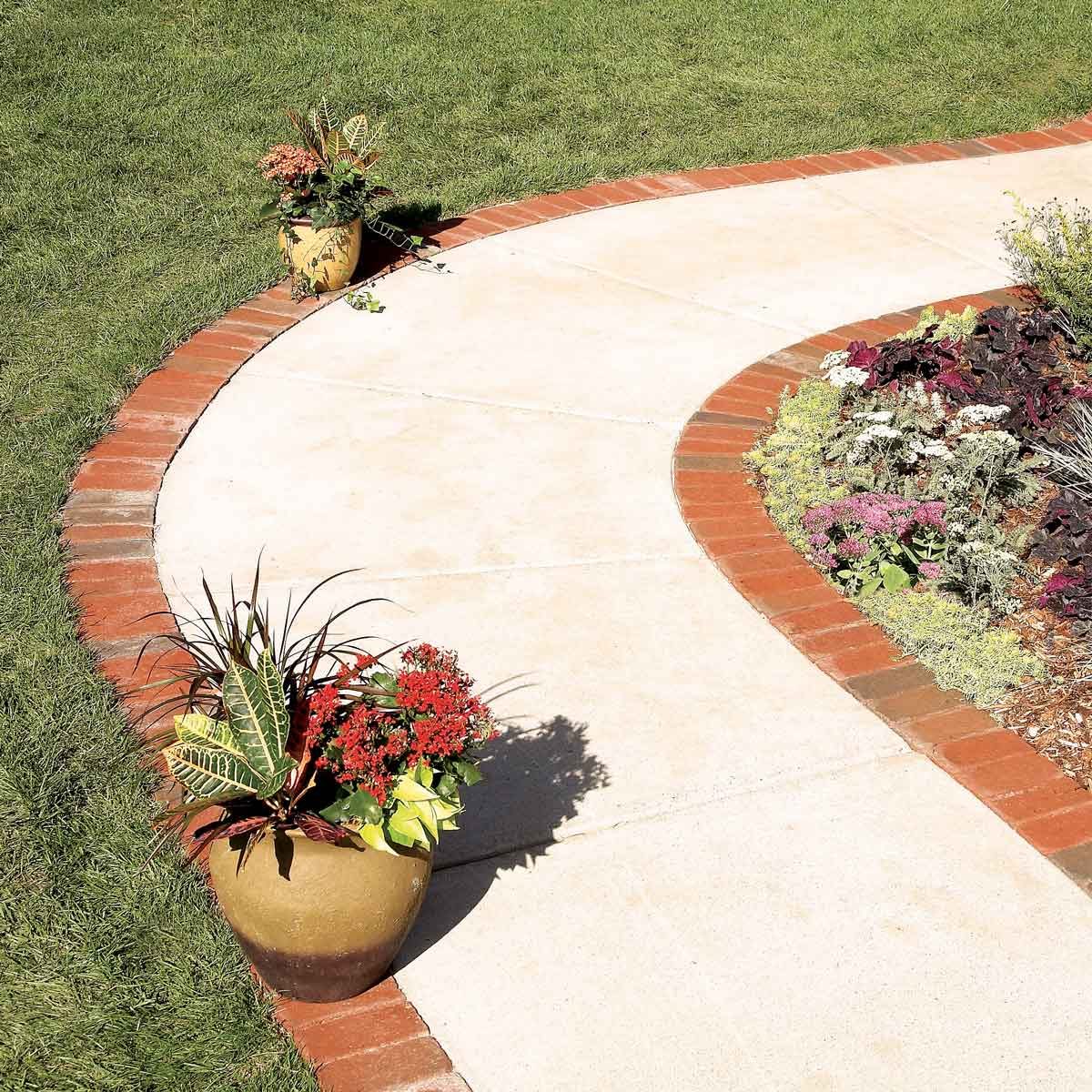
One of the most effective uses of brick edging is lining your walkways. Whether you have a winding garden path or a straight walkway leading from the driveway to your back porch, brick edging frames it perfectly.
This approach adds structure to softscaped paths—especially those made of gravel, mulch, or stepping stones. It also helps prevent materials from spilling into adjacent flower beds or lawns, reducing mess and maintenance.
The crisp, clean lines of brick work beautifully with everything from rustic cottage gardens to sleek modern patios. You can opt for a traditional flat row, an upright soldier course, or a decorative pattern like basket weave or herringbone.
For added drama, install lighting within or beside the brick edge, turning your path into a softly lit nighttime feature.
Walkway edging doesn’t just serve a practical purpose—it also elevates the overall feel of your landscape, tying together design elements and enhancing your curb appeal.
16. Painted Brick Edging

Want to make your garden edging pop with personality? Try painted brick edging for a custom, colorful twist on a classic style.
By painting your bricks, you can match or contrast your outdoor decor—from porch planters to garden furniture to the trim on your house. White-painted bricks create a crisp coastal look, while black or charcoal bricks deliver a more modern, high-contrast effect.
For a playful backyard, consider pastel tones or terracotta hues. You can even stencil on patterns or numbers for a more artistic approach.
Use outdoor masonry paint to ensure durability through all kinds of weather. And if you love to update your outdoor living space with the seasons, you can easily repaint each year for a fresh vibe.
This style is great for highlighting raised beds, framing garden paths, or simply giving new life to older bricks that need a facelift.
It’s a low-cost way to express your personal style while making your yard feel lively and cohesive.
17. Mosaic Brick Edging
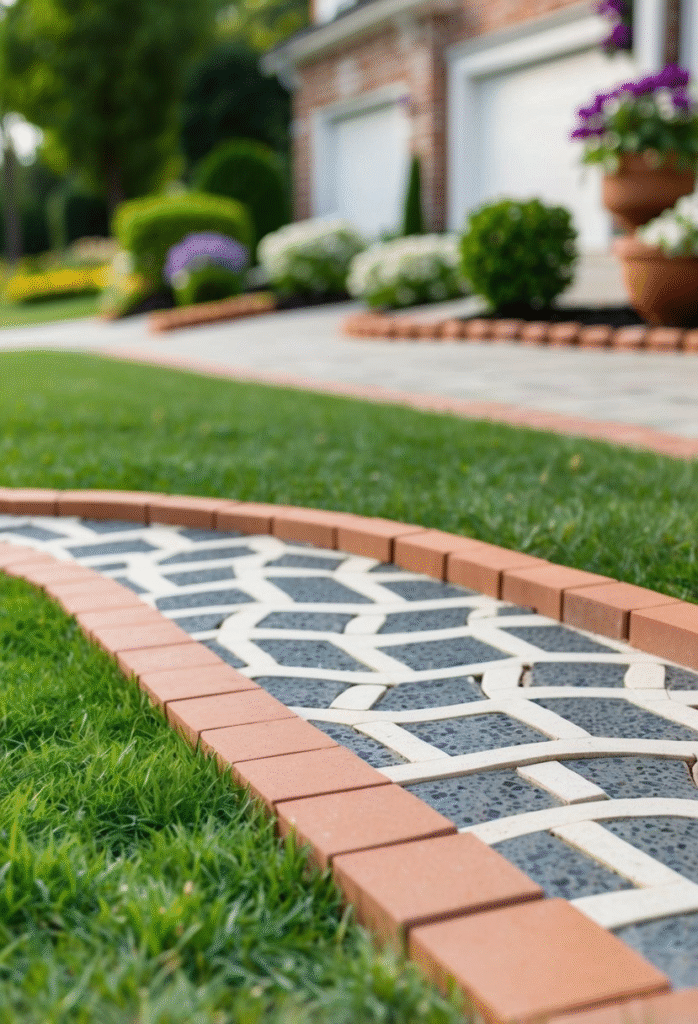
For a truly artistic edge, try combining bricks with mosaic insets. This garden edging idea turns a functional border into a piece of outdoor art.
You can incorporate bits of tile, stone, glass, or colored brick fragments into the tops or faces of your edging. The mosaic can be simple—a few colorful pieces embedded into each brick—or more elaborate, forming swirling patterns or images.
Mosaic brick edging is ideal for gardeners who want to add a handcrafted, whimsical vibe to their space. It’s perfect for flower beds, garden entrances, or anywhere you want to draw attention.
This style pairs especially well with eclectic outdoor furniture, repurposed decor items, or boho back porch setups. It’s a conversation starter that adds layers of texture and color to your landscaping.
Since it requires more effort and creativity, consider using it in small sections for the biggest impact.
18. Brick Edging with Capstones
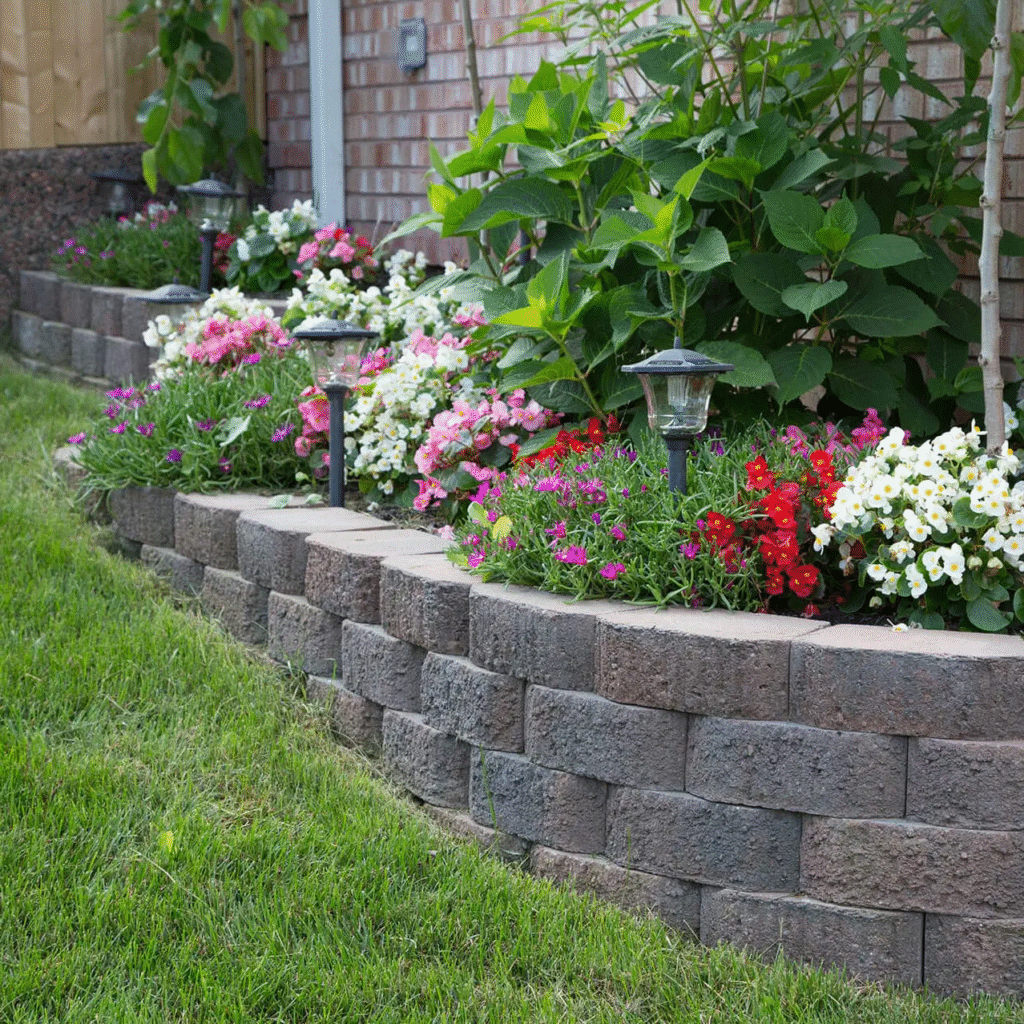
Capstones add a finished, upscale look to your brick garden edging—especially if you’re using stacked or mortared bricks for a raised edge.
These flat, often beveled bricks are placed on top of your brick edging to create a smooth, polished surface. They not only look fantastic but also help protect your wall from water damage and wear.
Capstones come in a variety of materials, including concrete, sandstone, or even polished brick, giving you lots of style flexibility. Choose a color that matches or contrasts with your primary brick for visual interest.
This style works wonderfully around patios, outdoor kitchens, or formal garden beds where you want a sharp, architectural finish. It also blends seamlessly into more modern outdoor living spaces with structured lines and luxury features.
Capstones can even double as informal seating when installed at a wider width—perfect for those backyard moments when you just want to perch and enjoy the view.
19. Brick Edging with Built-In Seating
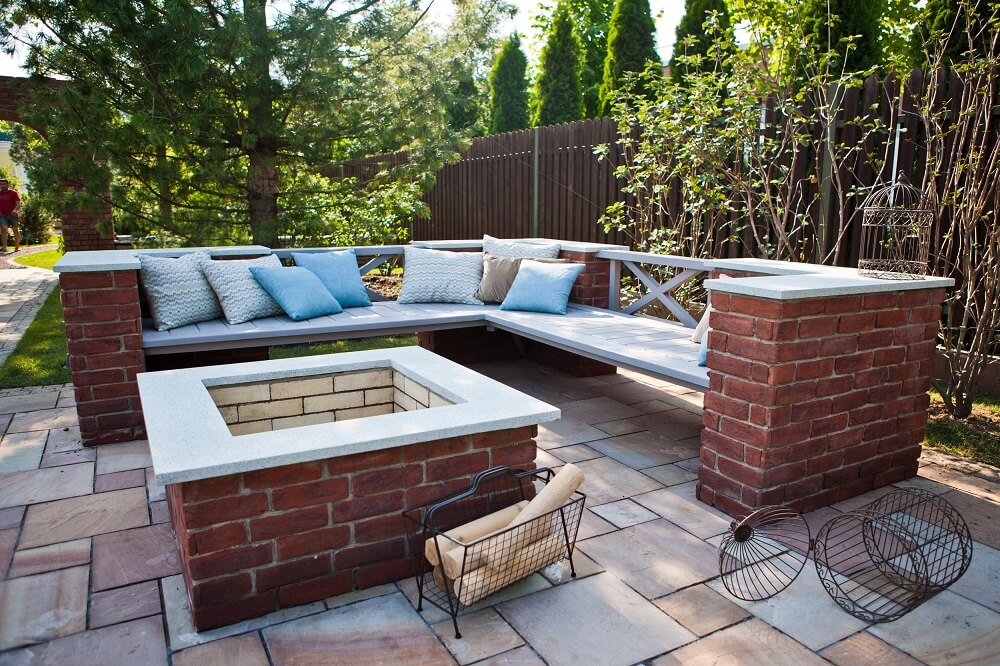
For the ultimate functional-meets-beautiful garden edging idea, consider designing a brick border that doubles as seating.
This involves building up your brick edging to bench height and topping it with a flat, comfortable surface like a wide capstone or wooden plank. The result? A cozy perch nestled alongside your flower beds or patio—a great spot to relax, sip iced tea, or enjoy your favorite garden book.
Built-in seating works especially well in smaller yards where space is limited. It offers structure, storage, and style in one clever design.
It’s ideal around firepits, near your back porch, or bordering vegetable gardens where you may want to take a break while harvesting. Pair it with cushions, climbing vines, or even low lighting for a dreamy backyard nook.
While this edging takes more planning and materials, the result is a luxurious, multipurpose feature that brings both comfort and curb appeal to your outdoor space.
Conclusion: Frame Your Garden with Style and Purpose
Brick garden edging is more than just a functional border—it’s a design tool that brings cohesion, character, and charm to your outdoor space.
Whether you’re leaning into rustic elegance, structured modern design, or whimsical artistry, there’s a brick edging style to match your vision. From flat traditional lines to creative mosaic borders and even built-in seating, each idea brings something unique to the table.
As you plan your landscaping projects, consider how your edging can enhance not just your garden, but your entire outdoor living experience. Tie it into your back porch decor, coordinate it with your modern patio furniture, and let it reflect your personal style.
With the right approach, brick garden edging can transform your yard from ordinary to exceptional—one brick at a time.

